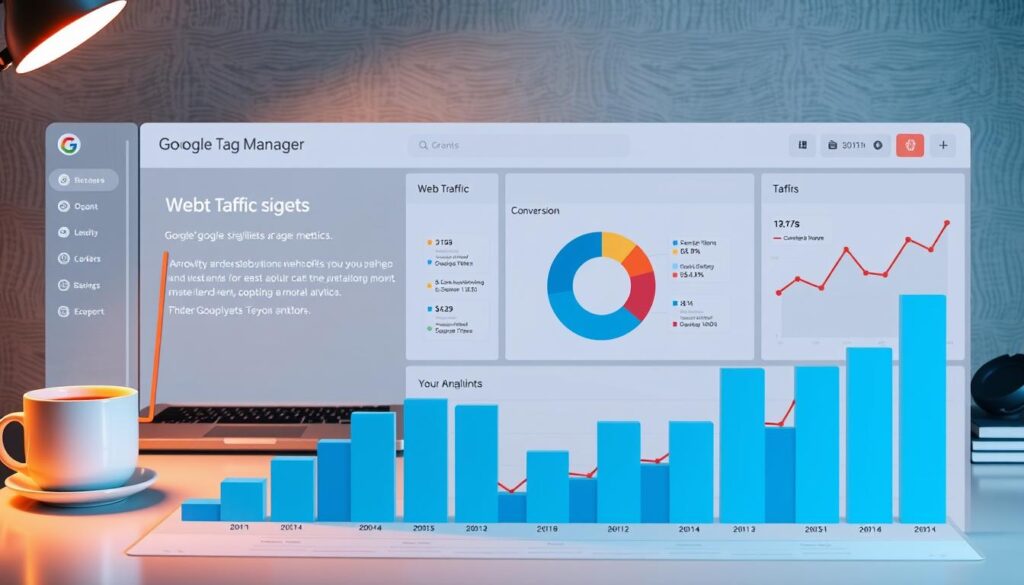In today’s world, using GTM analytics and reporting is key for any company wanting to improve. It offers a way to collect data efficiently, helping businesses understand how users interact with their website. This means they can make better decisions, create smoother experiences for users, and increase successful actions on their sites.
For marketers looking to handle data better, GTM is a must. Whether you’re just starting or have lots of experience, GTM can help. By making the most of GTM, companies can make smarter choices, better please their users, and see more success online.
Key Takeaways
- Understanding the role of GTM analytics and reporting is vital for optimizing digital strategies.
- Google Tag Manager provides an efficient framework for seamless data collection.
- Proper setup of GTM enhances user experience by enabling targeted tracking.
- Effective data analysis leads to better decision-making and increased conversions.
- Both beginners and experts can benefit from the robust features of GTM.
Understanding GTM Analytics and Reporting
Google Tag Manager (GTM) is a tool that helps with easily adding code to websites. It lets businesses track what visitors do without needing a lot of coding. With GTM, adding things like Google Analytics or Facebook Ads codes is simple. This makes digital marketing flexible and up-to-date.
What is Google Tag Manager (GTM)?
Google Tag Manager acts as a single place to manage code from many marketing tools. These pieces of code, or tags, gather tracking data. GTM’s simple interface lets you put tags to work easily and track important activities. It’s key for making smarter choices in business by understanding customer actions better.
The Importance of Analytics in Decision-Making
With so much data created every day, managing it right is vital. GTM helps businesses get insights from this data to know what customers like and do. By using analytics wisely, companies can see how they’re doing, tweak plans, and use their resources better. This helps businesses grow and make more money.
Key Features of GTM Reporting
GTM’s dashboard offers great features for better tracking and analysis. It lets users set up rules for when tags should work, like when a page is viewed or something is clicked. This makes the gathered data even more useful. GTM also has tools for changing how data is collected, helping marketers get key information easily.
Setting Up GTM for Effective Analytics
Google Tag Manager makes collecting and analyzing data easier. A detailed guide on GTM setup helps marketers start without dealing with complicated code. This allows them to focus more on analyzing data.
Step-by-Step GTM Installation Guide
To set up Google Tag Manager, first create an account and a container for your site. You will need to add GTM code snippets to the <head> and <body> sections of your website’s HTML. This makes it easy to add tags for tracking.
Configuring Tags, Triggers, and Variables
After installing, you’ll configure GTM. Set up tags to connect your site with tools like Google Analytics. Understand that triggers make tags work when users do something on your site. This improves how you collect data. Variables categorize metadata for tags, making GTM easier to manage.
Best Practices for Data Layer Management
Good data layer management is key for tracking. Regular checks of your GTM container get rid of old tags and keep things tidy. Organize your tags well, like by marketing or analytics purpose. Also, use version control to handle updates smoothly and keep data accurate. For more advice, check this guide on GTM best practices.

Analyzing Data with GTM Reports
Learning how to use GTM reports for data analysis is key for business growth. It starts with getting to know the GTM interface. This interface offers an easy way to get to important insights. It helps marketers manage tags and triggers better, making tracking key metrics simpler. These metrics aid in making strategic decisions.
Navigating the GTM Interface for Insights
Familiarizing yourself with the GTM interface is a must for using its reporting tools. The interface provides ways to break down data points. This breakdown improves the quality of insights you get. By navigating well, businesses pinpoint the most valuable insights. This makes the data collection for analysis stronger.
Customizing Your Analytics Reports
GTM stands out because it lets you tailor analytics reports to meet specific goals. You can choose metrics like conversions and user engagement rates. Focusing on these important metrics makes data clearer. Custom reports help teams understand analytics’ role in reaching business goals better.
Interpreting GTM Data for Business Growth
Understanding GTM data is crucial for finding growth opportunities. By looking at user behavior, companies see which pages work best and where to improve. This analysis aids marketing strategies for better website performance and user experience. Effective use of data means higher ROI and growth. For tips on increasing ROI with GTM, click here.

Enhancing GTM Analytics with Integrations
Integrating tools into Google Tag Manager (GTM) gives businesses great insight options. It boosts analytics and reporting accuracy. This supports smarter decision-making.
Integrating Google Analytics with GTM
Google Analytics integration makes tracking user actions easy. By using GA4 tags in GTM, businesses can watch how users interact. This makes moving to GA4 simple and boosts data on user engagement and conversions. With this integration, companies get deep insights for better strategies and marketing.
Using Third-Party Tools for Advanced Reporting
Adding third-party tools like Hotjar and Facebook Ads to GTM enhances its analytics. This merger broadens the data companies can analyze. It helps understand user interactions better, leading to accurate performance insights. A complete picture helps businesses improve their marketing approaches.
Benefits of Automation in Data Collection
Automation in GTM data collection is very beneficial. It cuts down manual work and makes tracking more efficient and accurate. With GTM automation, companies can focus on strategy instead of data entry. This leads to better performance outcomes.
| Integration Type | Benefits |
|---|---|
| Google Analytics Integration | Comprehensive tracking of user interactions and conversions. |
| Third-party Tools Integration | Enhanced reporting and insights from various marketing platforms. |
| GTM Automation | Reduced manual work and improved data accuracy. |
Common Challenges in GTM Analytics
Implementing Google Tag Manager (GTM) helps businesses use data for decision-making. But, there are obstacles that can hinder data collection and analysis. Identifying and fixing tracking problems is crucial; incorrect tags or trigger conditions can result in wrong data. Regular audits and using GTM’s preview mode are key to finding and fixing these issues, ensuring data remains accurate.
Accuracy and integrity of data are vital for reliable analytics. This means setting up good practices for managing tags, like clear naming and strict version control. Checking data regularly and validating it improves data quality. By doing this, businesses gain clear insights into user behavior and can tweak their marketing for better returns.
On the technical side, there can be challenges in setting up GTM that affect data collection. These issues might come from a lack of coding skills or difficulties with the data layer. Getting past these obstacles might mean training or help from GTM experts. Keeping up with Google’s updates and website tech helps businesses keep their setup effective for their analytics needs.
FAQ
What types of tags can be implemented in Google Tag Manager?
In Google Tag Manager, you can use many tags. These include Google Analytics, Facebook Ads, LinkedIn Insights, and even custom HTML or JavaScript tags. Such a variety lets you track user actions across different services easily.
How can businesses benefit from GTM analytics and reporting?
GTM analytics and reporting give businesses insights into how customers act. They make tracking easier and boost website performance. This leads to better decisions and more conversions.
What are triggers in GTM, and why are they important?
Triggers in Google Tag Manager activate tags based on certain user actions. Actions like clicks, form sends, or page visits are examples. They make sure you collect accurate data, which improves your analytics reports.
What are some best practices for data layer management in GTM?
Managing the data layer well involves checking your GTM container often. Also, organizing tags and using version control is key. These steps keep your data clean and help monitor performance.
How does GTM facilitate customized reporting?
GTM lets marketers focus on important data points for reports. They can look at conversion rates or how often users engage. With this info, businesses can make decisions that help them reach their goals.
What common tracking issues should be monitored in GTM?
Look out for tags that aren’t set up right or trigger problems in GTM. Regular checks and using the preview mode are good ways to find and fix these issues. This keeps your data collection accurate for better reports.
How can businesses automate data collection with GTM?
Businesses can automate collecting data with Google Tag Manager by creating triggers and tags. This makes the process smooth, cuts down manual work, and helps avoid mistakes in data tracking.
What support options are available for GTM implementations?
For GTM help, you can use online materials, forums, or talk to GTM pros. Staying up to date with training and best use practices is crucial for keeping GTM working well.



